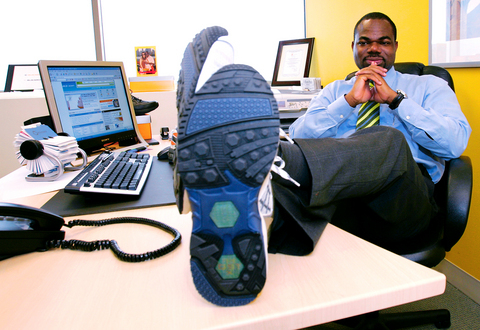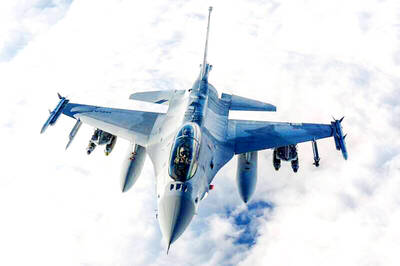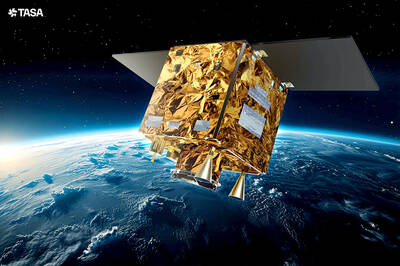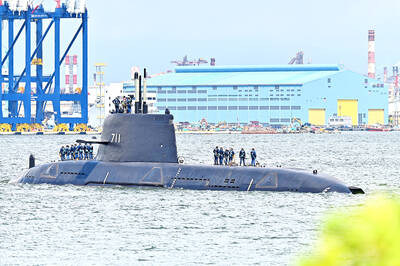Isaac Daniel calls the Global Positioning System chip he has embedded into a line of sneakers "peace of mind."
He wishes his eight-year-old son had been wearing them when he got a call from his school in 2002 saying the boy was missing. The worried father hopped a flight to Atlanta from New York, where he had been on business, to find the incident had been a miscommunication and his son was safe.
Days later, the engineer started working on a prototype of Quantum Satellite Technology, a line of US$325 to US$350 adult sneakers that will hit shelves next month. It promises to locate the wearer anywhere in the world with the press of a button. A children's line will be out this summer.

PHOTO: AP
"We call it a second eye watching over you," Daniel said.
It's the latest implementation of satellite-based navigation into everyday life -- technology that can be found in everything from cell phones that help keep kids away from sexual predators to fitness watches that track heart rate and distance. Shoes aren't as easy to lose, unlike phones, watches and bracelets.
The sneakers work when the wearer presses a button on the shoe to activate the GPS. A wireless alert detailing the location is sent to a 24-hour monitoring service that costs an additional US$19.95 a month.
In some emergencies -- such as a lost child or Alzheimer's patient -- a parent, spouse or guardian can call the monitoring service, and operators can activate the GPS remotely and alert authorities if the caller can provide the correct password.
But the shoe is not meant for non-emergencies -- like to find out if a teen is really at the library or a spouse is really on a business trip. If authorities are called and it is not an emergency, the wearer will incur all law enforcement costs, Daniel said.
Once the button is pressed, the shoe will transmit information until the battery runs out.
While other GPS gadgets often yield spotty results, Daniel says his company has spent millions of dollars and nearly two years of research to guarantee the accuracy of the product's chip, which is tucked into the bottom of the shoe.
Experts say GPS accuracy often depends on how many satellites the system can tap into. Daniel's shoe and most GPS devices on the market rely on four.
"The technology is improving regularly. It's to the point where you can get fairly good reflection even in areas with a lot of tree coverage and skyscrapers," said Jessica Myers, a spokeswoman for Garmin International Inc, a leader in GPS technology based in Kansas.
"You still need a pretty clear view of the sky to work effectively," she said.
Daniel, who wears the shoes when he runs every morning, says he tested the shoes on a recent trip to New Jersey.
It tracked him down the Atlantic Coast to the Miami airport and through the city to a specific building.
The company has also put the technology into military boots and is in talks with Colombia and Ecuador, he said.
But retail experts say the shoe might be a tough sale to brand-conscious kids.
"If [parents] can get their kids to wear them, then certainly there is a marketplace. But I think the biggest challenge is overcoming ... the cool marketplace," said Lee Diercks, managing director of New Jersey-based Clear Thinking Group, an advisory firm for retailers.
The GPS sneakers, available in six designs, resemble most other running shoes. The two silver buttons -- one to activate and one to cancel -- are inconspicuous near the shoelaces.
The company is selling 1,000 limited-edition shoes online and already has orders for 750, Daniel said.
Parents who buy the pricey sneakers don't have to worry about their kids outgrowing them fast.
This fall, the company is unveiling a plug-and-wear version that allows wearers to remove the electronics module from their old shoes and plug it into another pair of Daniel's sneakers.

LONG FLIGHT: The jets would be flown by US pilots, with Taiwanese copilots in the two-seat F-16D variant to help familiarize them with the aircraft, the source said The US is expected to fly 10 Lockheed Martin F-16C/D Block 70/72 jets to Taiwan over the coming months to fulfill a long-awaited order of 66 aircraft, a defense official said yesterday. Word that the first batch of the jets would be delivered soon was welcome news to Taiwan, which has become concerned about delays in the delivery of US arms amid rising military tensions with China. Speaking on condition of anonymity, the official said the initial tranche of the nation’s F-16s are rolling off assembly lines in the US and would be flown under their own power to Taiwan by way

OBJECTS AT SEA: Satellites with synthetic-aperture radar could aid in the detection of small Chinese boats attempting to illegally enter Taiwan, the space agency head said Taiwan aims to send the nation’s first low Earth orbit (LEO) satellite into space in 2027, while the first Formosat-8 and Formosat-9 spacecraft are to be launched in October and 2028 respectively, the National Science and Technology Council said yesterday. The council laid out its space development plan in a report reviewed by members of the legislature’s Education and Culture Committee. Six LEO satellites would be produced in the initial phase, with the first one, the B5G-1A, scheduled to be launched in 2027, the council said in the report. Regarding the second satellite, the B5G-1B, the government plans to work with private contractors

MISSION: The Indo-Pacific region is ‘the priority theater,’ where the task of deterrence extends across the entire region, including Taiwan, the US Pacific Fleet commander said The US Navy’s “mission of deterrence” in the Indo-Pacific theater applies to Taiwan, Pacific Fleet Commander Admiral Stephen Koehler told the South China Sea Conference on Tuesday. The conference, organized by the Center for Strategic and International Studies (CSIS), is an international platform for senior officials and experts from countries with security interests in the region. “The Pacific Fleet’s mission is to deter aggression across the Western Pacific, together with our allies and partners, and to prevail in combat if necessary, Koehler said in the event’s keynote speech. “That mission of deterrence applies regionwide — including the South China Sea and Taiwan,” he

‘NARWHAL’: The indigenous submarine completed its harbor acceptance test recently and is now under heavy guard as it undergoes tests in open waters, a source said The Hai Kun (海鯤), the nation’s first indigenous defense submarine, yesterday began sea trials, sailing out of the Port of Kaohsiung, a military source said. Also known as the “Narwhal,” the vessel departed from CSBC Corp, Taiwan’s (台灣國際造船) shipyard at about 8am, where it had been docked. More than 10 technicians and military personnel were on deck, with several others standing atop the sail. After recently completing its harbor acceptance test, the vessel has started a series of sea-based trials, including tests of its propulsion and navigational systems, while partially surfaced, the source said. The Hai Kun underwent tests in the port from